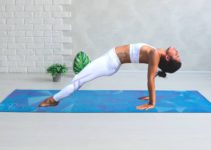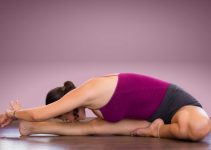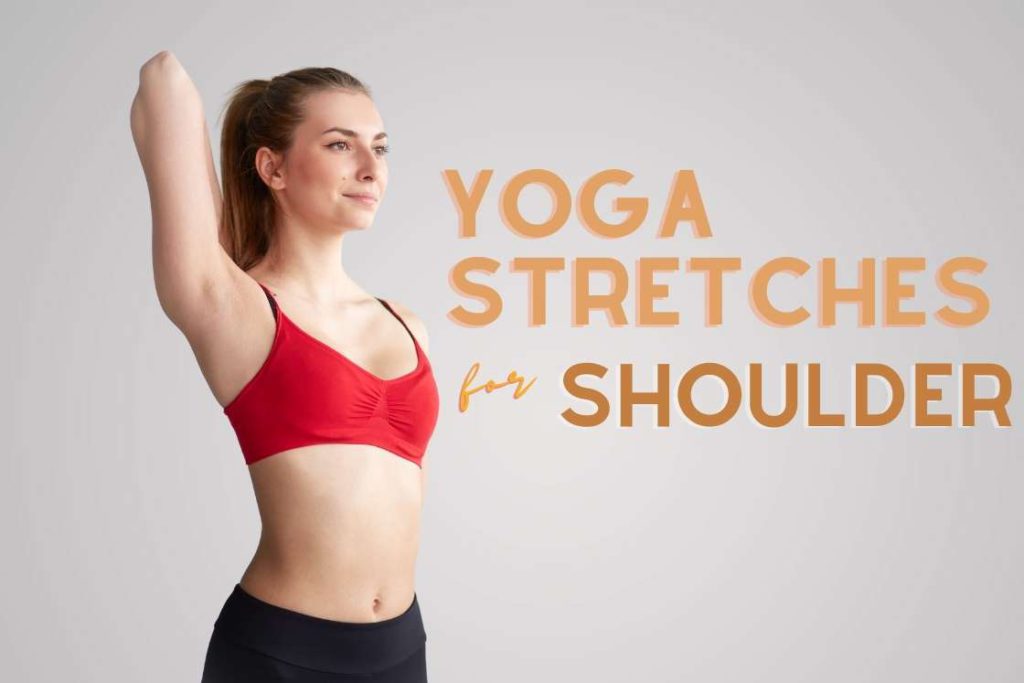
You may have never experienced the importance of shoulders until you deal with Shoulder pain. It is highly discomforting as it hinders all your daily activities. Luckily, Yoga can help us relieve Shoulder pain and uneasiness.
Yoga tackles shoulder pain by relaxing your muscles of the neck, back, and upper body. The intense physical demand in yoga shoulder stretches keeps you moving, but at the same time, it is gentle enough not to aggravate the shoulder pain further.
Yoga’s way of dealing with Shoulder Pain
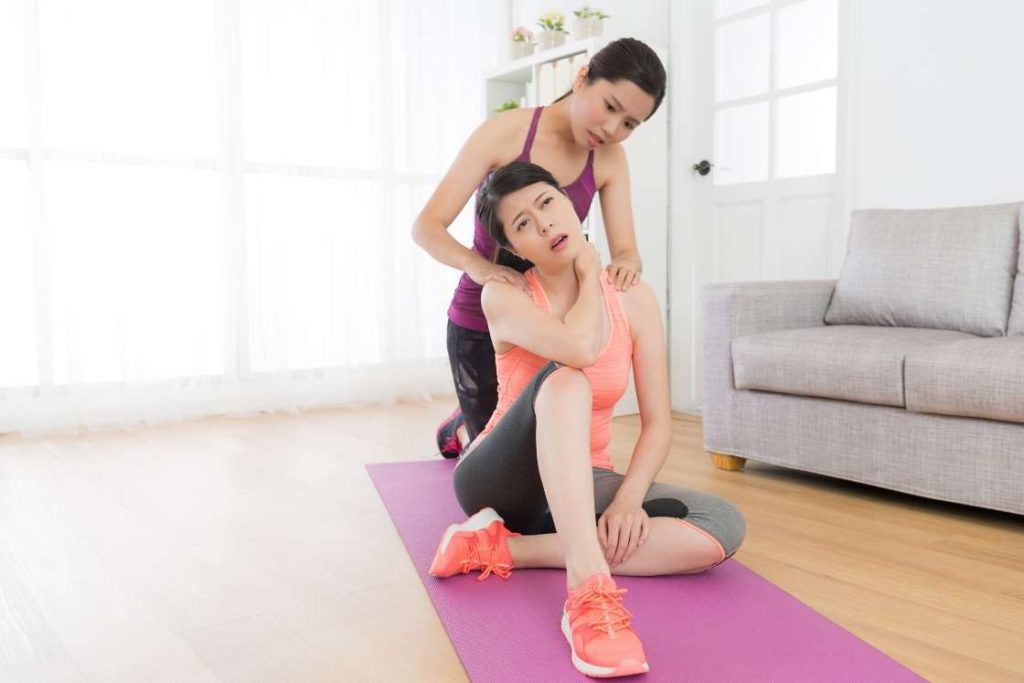
Yoga gives a balanced approach while looking for relief from Shoulder Pain. In most cases, the tightness in the Trapezius muscles (a triangular muscle that connects the spine, neck, and shoulders) is the reason for pain and discomfort ness in the shoulder.
It’s found in a 2018 study, static yoga postures [efn_note] Scapular Muscle Activity During Static Yoga Postures https://www.jospt.org/doi/full/10.2519/jospt.2018.7311 [/efn_note] are very helpful to activate the scapular stabilizer muscles at varying levels of activity. Scapular stabilizer muscles are an important component of shoulder rehabilitation.
Yoga for shoulder pain relief works in the following way;
1. Improving Flexibility and Balance
Yoga involves a range of motion as well as flexibility poses that directly target Shoulder Pain. As a result, one can see a drastic reduction in shoulder stiffness. In addition to this, simple stretches and spinal twists improve muscle strength in Spine [efn_note] Basic Principles Regarding Strength, Flexibility, and Stability Exercises https://www.sciencedirect.com/science/article/abs/pii/S1934148212010507 [/efn_note], Shoulders, and neck. All these organs are highly interconnected and co-ordinated. One inculcates balance by Alignment, strength as well as mental focus while practicing the poses.
2. Aides Mental Well-Being
There is always some emotional pain hidden behind physical pain in different parts of the body, the same applies to shoulder pain. It’s found in a yoga national survey in Australia [efn_note] Yoga in Australia: Results of a national survey https://www.ncbi.nlm.nih.gov/pmc/articles/PMC3410203/ [/efn_note], however, most people used yoga for stress management and anxiety but it also addresses back pain, neck pain, shoulder pain, and other related musculoskeletal problems.
Yogic breathing techniques, aka Pranayama, and relaxation yoga poses like Child Pose or Savasana are self-soothing and healing in Nature. They help in decreasing physiological arousal, reduces the heart rate, lowers blood pressure, and controls respiration. Therefore, relaxed Muscles won’t generate Shoulder Pain.
3. Reduces Inflammation
Inflammation is caused due to overuse of shoulder joints, some minor injury, or any chronic conditions. Yoga therapy focuses on strengthening and mobilizing the shoulders. Practicing asanas daily keeps the shoulder active and helps speed up the recovery.
Practicing restorative asanas like Eagle Pose (Garudasana), Bridge Pose (Setubandhasana) reduces shoulder inflammation gradually. One can use Props like bolsters, bricks, pillows to practice static poses to support your condition.
4. Builds Strength
Yoga Practices stabilizes and strengthens your joints. With constant practice, one can regain mobility in the shoulders and get rid of the causes which result in Shoulder Pain.
Yoga asanas like Downward Facing Dog, Handstand, Bow Pose, demands arm strength by pushing away from the floor. The resistance creates a pull in the shoulder muscles. Gradually, one regains mobility in the joint thereby curing the condition.
Yoga Poses to Relieve Shoulder Pain
Here are a few pointers which one can keep in mind before starting their yoga practice in shoulder pain.
- One can start with Yoga Warm-up, which is also known as Sukshma Vyayam, or subtle exercises.
- Check the alignment of your shoulders before practicing any pose so as to protect them from any unnecessary strain.
- Ensure that whatever asanas or poses you are practicing are slow and gentle. Any extra pressure will aggravate the problem instead of healing it.
- Maintain your presence of mind and enjoy your process.
Try these 7 yoga stretches to relieve your shoulder pain:
- Warrior 2 Pose
- Cat-cow stretch
- Extended puppy pose
- Eagle pose
- Wide-Legged Forward Bend, hands overhead
- Reverse prayer pose
- Upward plank pose
1. Warrior 2 Pose (Virabhadrasana 2)

Coming into the warrior 2 pose easily gives a gentle stretch to your shoulder. Adding a little variation of rotating arms externally and internally in this pose increase the shoulder joint mobility.
The warrior 2 stretch for shoulder pain is most relaxing when pain occurs after a period of inactivity or bad posture due to ‘hunched shoulders’. The pose allows you to correct the overall posture including neck and spine alignment, which plays important role in shoulder pain.
Instructions
- From tadasana position, bring your left foot back and right foot forward, making a wide stance in between your legs.
- Turn your right foot forward at 90 degrees and the inside of your left foot should be in line with your right foot.
- Bring up your arms to bring them parallel to the floor, palms facing down.
- Bend your right knee, being careful not to extend your knee further forward than your ankle.
- Press into both feet as you extend up through your spine.
- Look out past your right fingertips.
- Remain in this pose for 30 seconds.
- Then do the opposite side.
2. Cat-Cow Stretch (Chakravakasana)
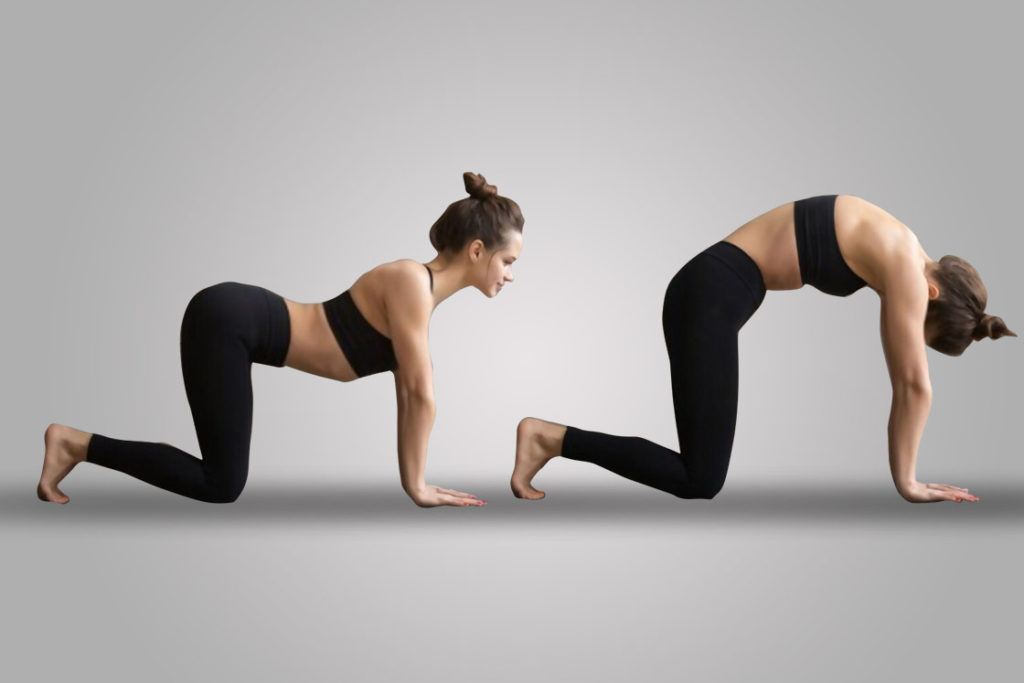
Cat-cow stretch directly targets your spine regions as well as your shoulder muscles. In cervical radiculopathy, aka “pinched nerve”, the pain actually arises from the spinal cord and spread across the neck to the shoulder region. Stretching back in the cat-cow pose brings mobility in the spinal vertebrae that further relief shoulder pain.
Instructions
- Get down on all four, your hands and your knees.
- Keep your hands shoulder length apart and your feet hip length apart. Your hands should be exactly under your shoulders and your knees under your hips.
- Keep your feet with toes against the floor and heels toward ceiling.
- Now just like the posture of a cow, with an inhale drop down your belly and arch your upper body and head upward to look at the ceiling.
- Keep your arms straight and shoulder blades pressed against each other. Do not squeeze your shoulders. Keep your neck, free and separate from your shoulders.
- Now exhale, and curl up your belly against your spine, like a cat, and rest the top of the feet against the floor.
- Repeat this 5-10 times.
3. Extended puppy pose (Uttana Shishosana)
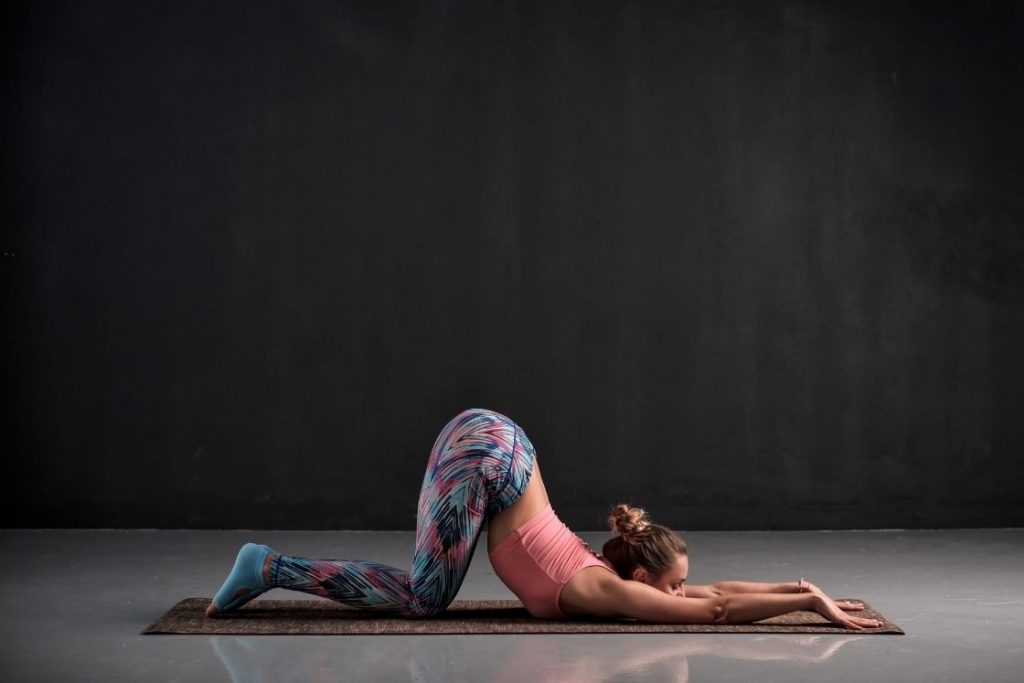
The puppy pose is a perfect pose for your shoulders. Even while practicing this pose, you will be able to the epicenter of the pose being created in your shoulders. The puppy pose will relax, stretch and open up your shoulder muscles and joint. Apart from the therapeutic relief from pain, as you regularly practice this pose, your shoulder muscles will develop greater load capacity and range of motion. This will reduce tension on the joint and ligaments.
Instructions
- So first you will need to sit in Vajrasana, and slightly open up your knees.
- Raise your hands above your head, inhale and stretch down and front for the child’s pose. Rest here and take a few breaths.
- Now when you are ready, with an inhale, slowly slide forward, putting your chest against the floor and buttocks up in the air, right above your knees.
- Keep breathing for about 10 seconds, you will feel the pose opening up your shoulders.
- Then slide back to child’s pose and release.
4. Eagle Pose (Garudasana)
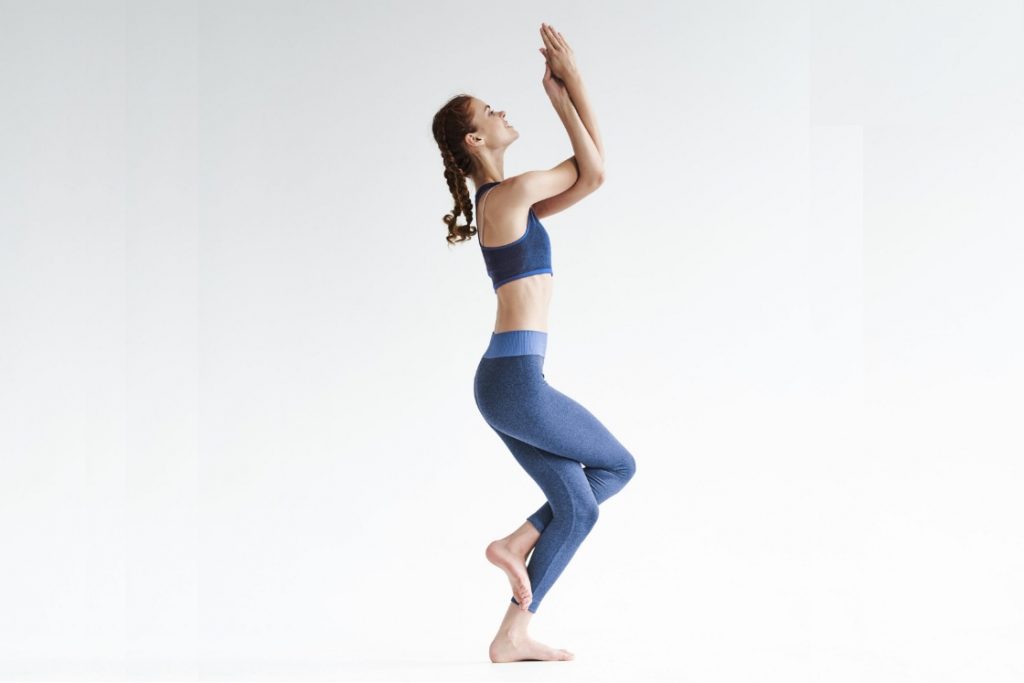
Garudasana is an antidote for your shoulder pain. It is highly effective for neck and shoulder flexibility and strength. It stretches the muscles between your shoulder blades.
The arm position in the Eagle pose releases the tension in the often contracted base of the neck which is the area between shoulder blades. Garudasana is often referred for the best way to remove tension from your shoulders.
Instructions
- Stand straight with your feet joined. Raise up your hands straight in front of your body.
- Now bend your knees. Shift your weight to your right leg, and bring your left thigh over your right thigh and hook your left feet around your right calf muscles.
- Bend your elbows and point your arms upward with your open palms (facing you) pointing upward as well.
- Now now cross your elbows, by bringing your left elbow through under your right elbow, and then crossing again your wrists by bringing your left wrist over your right wrist.
- Hold in this position for 5-10 breaths, and repeat the steps by switching the roles of your hand and legs
5. Wide-Legged Forward Bend, Hands Overhead
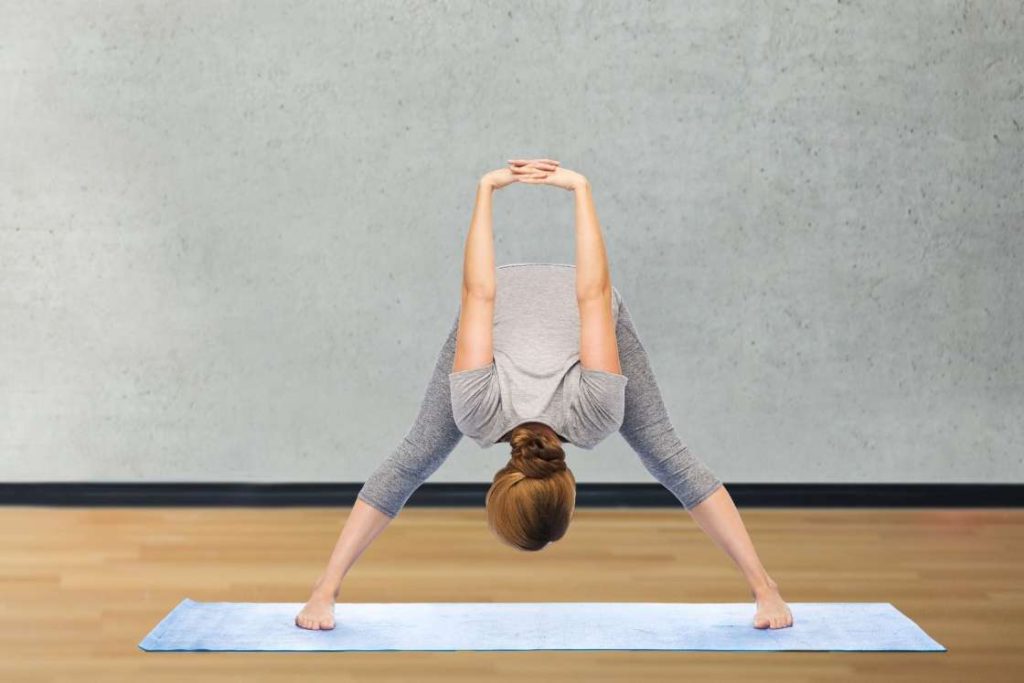
The wide-legged forward bend is pose that works wonders on your abs and hamstrings, but adding the overhead arms postures, include your shoulders as well. The natural downward pull on your shoulders from the bend, gives your shoulders the much needed backward stretch, that it often lacks in your daily activities. Naturally, this pose will set up your shoulder joint for a diverse capacity of tasks.
Instructions
- Stand straight with your legs wide apart. Keep your legs approximately 3 feet wide.
- Straighten your hands and interlace your fingers behind your back.
- Now bend your body from your groin and bring your upper body downwards.
- Now don’t move your shoulders or arms separately, just let it roll along with the motion of your body. This should bring your hands right above your head.
- Feel the pull at your shoulders, stay in the pose for 10 seconds and repeat the pose for 5 repetitions.
6. Reverse Prayer Pose (Paschim Namaskarana)
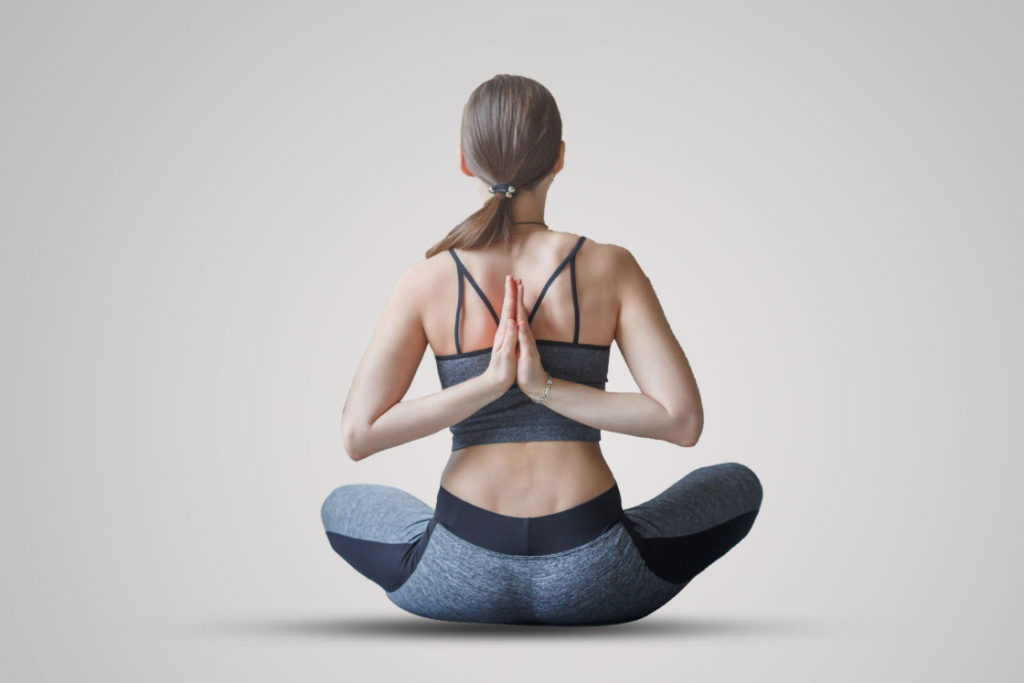
Relieving shoulder pain is as simple as joining hands behind your back. As simple as it may seem, the Reverse prayer pose aids shoulder movements and helps open up the chest. It is also beneficial to loosen any tight shoulder muscle as it relaxes the shoulder blades and hence lessens the shoulder pain.
Reverse Prayer Pose also calms the mind and relaxes the nervous system. This indirectly releases the tension from the shoulder muscles. Hence, it beats the problem in a very effective way.
Instructions
- This pose is going to need some shoulder flexibility in advance, thus try grabbing your opposite elbows behind your back, and hold for a minute. Repeat this for few days, and once you have the required flexibility, proceed with the pose.
- Sit in a comfortable cross-legged position. Keep your upper body and back straight.
- Now puff out your chest and press in your shoulder blades as much in as possible,.
- Now join your hands behind your back, with your palms touching each other.
- Your hands need to go upto the middle of your shoulder blades.
- Hold the pose for 5 breaths and release.
7. Upward Plank (Purvottasana)
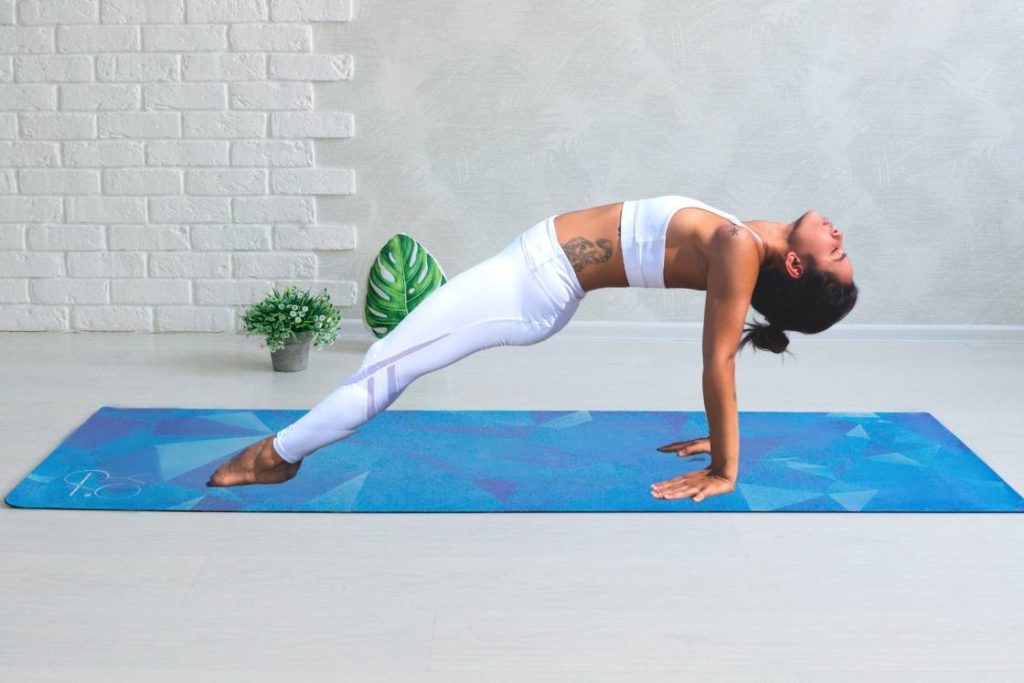
Upward Plank Pose is known for its great ability to provide nice stretch in arms, wrist, and especially in shoulders, back, and spine. It helps increase blood flow in the shoulders and relaxes your muscles.
One can practice Upward Plank to counterfeit Shoulder Pain by practicing it regularly. Daily practice will strengthen your upper body and gives strength to the muscles in your shoulders.
Instructions
- Sit in a staff pose, with your legs stretched straight Infront of you, feet joined and back straight.
- Now place your hands beside your sitting bones and rest your elbows on the ground. Now precisely where your elbows rest, bring your palms to that exact position. This will help you maintain proper posture on the rise.
- Now straighten your hand, and press down your heels, to lift your body upwards in a plank position.
- Lift your pelvis upward till your body is in a downward sliding ( from head to feet ) posture.
- Put your hamstrings, buttocks and lower back into the lift.
- Let your toes fall to the ground.
- Keep your muscles active and hold the pose for 10 breaths, and release the pose.
Conclusion
There’s always so much we want to do when we suffer from acute Shoulder pain. Usethis yogic guide to practice various aasanas to improve your condition. And then see theresults for yourself!
Yoga should not be only be used as a curative approach, but also as a preventive approach. Practicing Yoga has been rewarding since thousand of years. As not only itsbenefits are emphasized on physical fitness but also mental fitness.

